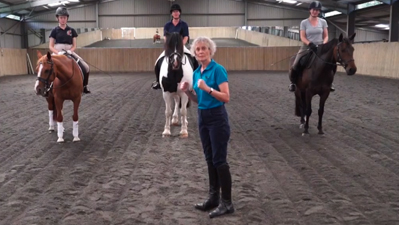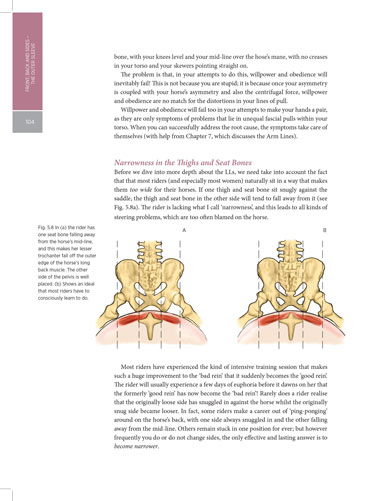
RIDER BIOMECHANICS COURSE
BASED ON THE LATEST BOOK BY MARY WANLESS
Just one of the many courses available as part of membership to Dressage Training TV
6 RECORDED 1 HOUR SESSIONS
Recorded in our indoor arenas using real riders and horses to demonstrate how the rider's skill can influence the shape of the horse's back and cause them to move into 'The Seeking Reflexes'
Plus access to forums to ask questions which will be answered by a RWYM coach. Plus download a digital version of the book 'Master Dressage - The Basics' for free. Plus an extra BONUS Session.
Imagine a ride with no shoving, pushing, pulling or fiddling. This is rider biomechanics – making the impossible possible, the possible easy and the easy elegant...
Plus access to forums to ask questions which will be answered by a RWYM coach. Plus download a digital version of the book 'Master Dressage - The Basics' for free. Plus an extra BONUS Session.
IMPROVE YOUR SEAT & GAIN INFLUENCE
With focus on stability, tone and core you will learn how to sit better, be less effected by the horse's contortions and begin to shape the horse correctly through good rider biomechanics.Imagine a ride with no shoving, pushing, pulling or fiddling. This is rider biomechanics – making the impossible possible, the possible easy and the easy elegant...
YOUR COACH – MARY WANLESS

Mary Wanless BHSI BSc is an internationally renowned coach, and is the author of the Ride With Your Mind books. She coaches riders at all levels, from relative novices to two of the top 12 US dressage riders, and some of the Canadian Eventing Squad. She has B.Sc. Degrees in both Physics and Applied Sports Coaching, and holds the BHSI certificate.
DID YOU KNOW THAT MARY: Rode with the late Nuno Oliveira, and over the years she has spent many months training in Portugal. Mary has ridden in Germany with the late Egon Von Neindorff and has trained in Germany with Hans Heinrich Meyer-Zu-Strohen.
DON'T MISS OUT ON THIS GREAT COURSE...
MEMBERSHIP OPTIONS
Monthly Membership
£17.50.
PRICE INCLUDES:
• Up to 5 hours of Live/Recorded sessions each month
• Subjects include: Rider Biomechanics, On The Bit, Schooling, Groundwork, Dressage Test Riding, Equine Massage, Yoga, Feldenkrais and more...
• Additional material each month including articles, audio and supplementary videos
• Save £££££ over buying courses separately
• Cancel your membership at any time
3 Monthly Membership
£40.
Works out just over £13 per month
**ONLY AVAILABLE FOR A LIMITED TIME**
PRICE INCLUDES:
• Up to 5 hours of Live/Recorded sessions each month
• Subjects include: Rider Biomechanics, On The Bit, Schooling, Groundwork, Dressage Test Riding, Equine Massage, Yoga, Feldenkrais and more...
• Additional material each month including articles, audio and supplementary videos
• Save £££££ over buying courses separately
• Ongoing subscription. Cancel your membership after 3 months
6 Monthly
£78.
Works out as only £13 per month
PRICE INCLUDES:
• Up to 5 hours of Live/Recorded sessions each month
• Subjects include: Rider Biomechanics, On The Bit, Schooling, Groundwork, Dressage Test Riding, Equine Massage, Yoga, Feldenkrais and more...
• Additional material each month including articles, audio and supplementary videos
• Save £££££ over buying courses separately
• Ongoing subscription. Cancel your membership after six months
Yearly Membership
£150.
Best Value 41p per day
PRICE INCLUDES
• Regular Q&A Sessions
• Up to 5 hours of Live/Recorded sessions each month
• Subjects include: Rider Biomechanics, On The Bit, Schooling, Groundwork, Dressage Test Riding, Equine Massage, Yoga, Feldenkrais and more...
• Additional material each month including articles, audio and supplementary videos
• Save £££££ over buying courses separately
• Ongoing subscription. Cancel your membership at the end of the year
JOIN DRESSAGE TRAINING TV TODAY AND GET ACCESS TO...
- Up to 5 hours of new video every month – with more and more videos and courses being added all the time
- Multiple courses – covering everything from groundwork to rider biomechanics to competing.
- Over 20hrs of existing videos and courses available on sign-up.
- Groundwork Certification Programme with Certificates & Badges
- Cohesive coaching system – based on Ride With Your Mind Rider Biomechanics – no confusing or conflicting techniques!
- 15% Discount – a members only discount on riding products in our shop which is expanding all the time.
- Suitable for all levels – novices, riding school riders, experienced riders, competitive riders and coaches.
- Best Selling Authors Mary Wanless & Peter Dove, and senior RWYM coach Ali Wakelin, guide you through video, articles and live online training sessions
- Join today – and download the digital version of the book 'Master Dressage – The Basics'.
MEMBERS COURSES

RIDER BIOMECHANICS - THE BOOK

RIDER BIOMECHANICS - How to Sit Better & Gain Influence
The course is based on the latest book from Mary Wanless, order your copy here.
SUMMARY FROM THE NEW BOOK: Rider Biomechanics
Rider Biomechanics begins by explaining fascia – the 'cinderella of body tissues'. Until recently, this was ignored by science, consigned to its apparent role as the body's packing material. However, research shows that in reality, this biological fabric links muscles into functional chains, just as the sausage skin links sausages.
Recent research has shown that the horse's fascial system is remarkably similar to our own, with equivalent ‘lines of pull’ that affect posture, movement, stability and mobility. Inevitably, the problems inherent in sitting and riding well are magnified when there is imbalance within and between the fascial 'guy ropes' of rider and/or horse. Realise that imbalance in either partner can send the other 'out of true’, whilst the 'equipoise' of one partner helps the other to regain that poise.
Talented riders use their well-balanced guy ropes to stabilise themselves and rebalance their horses. They also have enhanced ‘feel’, since fascia contains many more sensory nerves than muscles. These are registering the forces that pull on an area, and thus a ‘fascial net’ under tension creates a wellspring of strength and feel. This is denied to the majority who are more loosely strung – and however much they would love to be more quiet, effective riders, they are inevitably ‘bobbled about’ by the horse’s movement. But by working through this book, and learning to access and rebalance your own fascial net, your stability, skill and ‘feel’ can be significantly improved.
Rider Biomechanics first addresses the 'outer sleeve' of the body. Whether you tip forward, tip back, round your back or hollow it, your habits are based on fascial imbalance. So is the enhanced difficulty of circling in one direction. Practical exercises, enhanced with copious photographs and diagrams, show how to balance your front and back, right and left – yielding skills that simultaneously address the equivalent imbalances in your horse.
Mary then explains how effective force transmission within the fascial system enables the rider to push her hands forward, taking away the temptation to pull on the reins. Later chapters show how twists and distortions in both human and horse can be addressed through accessing the fascial lines that wrap diagonally around the body. Lastly, a look at the core of both partners shows just how profound their connection can become.
Rider Biomechanics begins by explaining fascia – the 'cinderella of body tissues'. Until recently, this was ignored by science, consigned to its apparent role as the body's packing material. However, research shows that in reality, this biological fabric links muscles into functional chains, just as the sausage skin links sausages.
Recent research has shown that the horse's fascial system is remarkably similar to our own, with equivalent ‘lines of pull’ that affect posture, movement, stability and mobility. Inevitably, the problems inherent in sitting and riding well are magnified when there is imbalance within and between the fascial 'guy ropes' of rider and/or horse. Realise that imbalance in either partner can send the other 'out of true’, whilst the 'equipoise' of one partner helps the other to regain that poise.
Talented riders use their well-balanced guy ropes to stabilise themselves and rebalance their horses. They also have enhanced ‘feel’, since fascia contains many more sensory nerves than muscles. These are registering the forces that pull on an area, and thus a ‘fascial net’ under tension creates a wellspring of strength and feel. This is denied to the majority who are more loosely strung – and however much they would love to be more quiet, effective riders, they are inevitably ‘bobbled about’ by the horse’s movement. But by working through this book, and learning to access and rebalance your own fascial net, your stability, skill and ‘feel’ can be significantly improved.
Rider Biomechanics first addresses the 'outer sleeve' of the body. Whether you tip forward, tip back, round your back or hollow it, your habits are based on fascial imbalance. So is the enhanced difficulty of circling in one direction. Practical exercises, enhanced with copious photographs and diagrams, show how to balance your front and back, right and left – yielding skills that simultaneously address the equivalent imbalances in your horse.
Mary then explains how effective force transmission within the fascial system enables the rider to push her hands forward, taking away the temptation to pull on the reins. Later chapters show how twists and distortions in both human and horse can be addressed through accessing the fascial lines that wrap diagonally around the body. Lastly, a look at the core of both partners shows just how profound their connection can become.

